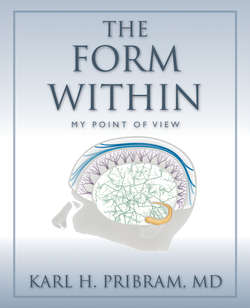Читать книгу The Form Within - Karl H Pribram - Страница 35
На сайте Литреса книга снята с продажи.
The Retina: Key to Formative Brain Processing
ОглавлениеIn contrast to the rather straightforward use of the experimental technique of microelectrode recording to understand the form of processing in the circuits of the brain, the small diameter of the dendritic branches makes the electrical recordings of the web a real challenge. Nonetheless, techniques were developed early on, in the 1950s, that allowed us to map the receptive fields that are formed in the dendritic web. How these mappings are made is described in the following sections.
An anecdote highlights the issue: In the early 1970s, I attended an International Physiological Congress where the keynote speaker was the noted British scientist A. L. Hodgkin. Two decades earlier, he had received the Nobel Prize, with A. F. Huxley, for the elegant mathematical description of the results of their experiments on the generation of nerve impulses.
Hodgkin began his address with the question: “What does one do after winning the Nobel Prize?”
He had thought a while about this, he said, and realized that he had not become a neurophysiologist merely to describe how a membrane generates a nerve impulse. No, he was interested in how the brain works—how it regulates the way the body operates, and how it makes our conscious experience possible. What followed his realization, he told us, was a brief period of depression: alas, he was not a brain surgeon and didn’t have the tools to address the problems that initially had challenged him. (His prize-winning experiments were actually done on the very large nerve fibers of crayfish.) One morning, however, Hodgkin had awakened with a promising insight: God, he realized, had put a piece of brain outside the skull, just so that physiologists such as himself could study it without having to drill holes to get at it!
That piece of “brain” is the retina of the eye. The retina, like the brain cortex, is made up of layers of nerve cells with the same fine-fibered profusion of branches. These fine fibers are present between the layers that reach from the receptors inward, and they also make up a feltwork, a web, within each of these layers. Hodgkin went to work on the retina at once. He told us that he was surprised and amazed by what he found—or rather by what he didn’t find: Over the next decade, in his many studies, he hardly ever encountered a nerve impulse, except at the very final stage of processing—the stage where those nerves with large diameters, large axons, generate signals that are transmitted to the brain. Therefore, everything we “see” is first processed by the fine fibers of the retina before any nerve impulses are actually generated.
11. The Fine-Fibered Neuro-Nodal Web in the Retina
Scanning electron micrograph showing the arrangement of nerve fibers in the retina of Necturus. Fibers (dendrites) arise in the inner segment and course over the outer segment of a cone. Note that points of contact do not necessarily take place at nerve endings. (From Lewis, 1970.)
The situation that Hodgkin found in the retina is identical to what occurs in the web of dendrites in the brain cortex: processing occurs in the fine fibers, and these processes compose and form the patterns of signals relayed by axons, the large nerve trunks.
